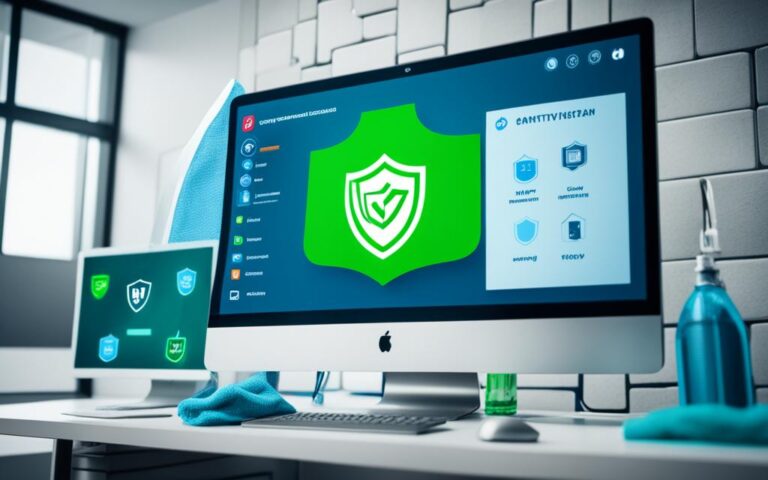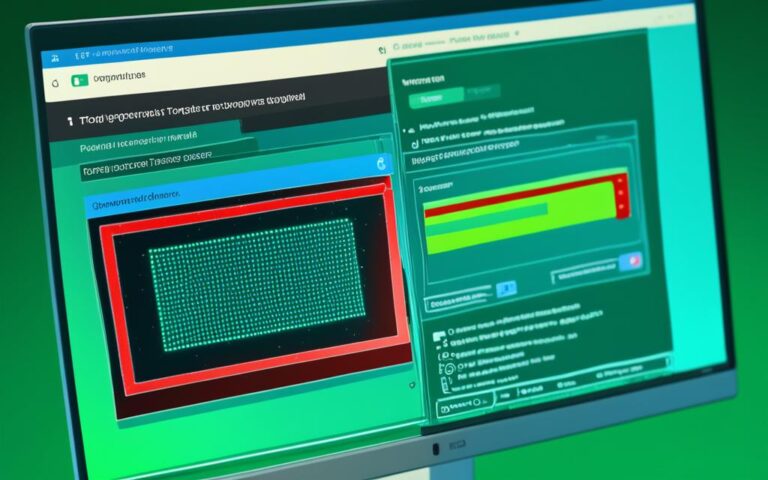Spyware Cleanup Challenges in the Modern Digital Landscape
In today’s highly interconnected digital world, spyware has become pervasive, infiltrating devices through various channels and compromising privacy and security. The increasing sophistication of spyware and its ability to evade detection make it a pressing challenge in today’s digital landscape. To counter spyware’s digital impact, effective cleanup strategies and cybersecurity measures are essential.
Spyware, also known as surveillanceware, is a malicious software that secretly monitors and gathers information about a user’s computer or online activities without their consent. It poses significant risks to individuals, businesses, and critical infrastructure.
Understanding spyware and its implications is crucial to protect against its digital impact. By prioritizing cybersecurity awareness, robust security measures, and staying informed about spyware detection and prevention, individuals and organizations can effectively mitigate the risks posed by spyware in today’s evolving digital landscape.
Understanding Spyware and Its Implications
Spyware, also referred to as surveillanceware or spyware, is a type of malicious software designed to covertly monitor and gather sensitive information from a user’s device. It can infiltrate computers, smartphones, and other devices through deceptive downloads, email attachments, compromised websites, or phishing attacks.
Spyware can collect various types of data, including keystrokes, browsing history, login credentials, and personal messages. This stolen information can be used for data theft, surveillance, identity theft, adware, keylogging, screen capture, remote control, and other malicious activities. The implications of spyware are far-reaching, compromising privacy, security, and personal well-being.
“Spyware can silently observe your every move, recording your online behaviors and personal information, leaving you vulnerable to privacy breaches and cybercrimes.”
Understanding spyware is crucial to protect against its digital impact. By recognizing the methods through which spyware infiltrates devices and the potential harm it can cause, individuals and organizations can take proactive measures to safeguard their privacy and security.
The Infiltration Methods of Spyware
Spyware employs various techniques to infiltrate devices and gather information without the user’s knowledge. Some common methods include:
- Deceptive downloads: Spyware can disguise itself as legitimate software or masquerade as a useful tool, enticing users to download and install it unknowingly.
- Email attachments: Spyware can be distributed through malicious email attachments, exploiting users’ curiosity or trust.
- Compromised websites: Visiting compromised or malicious websites can lead to unintentional spyware downloads.
- Phishing attacks: Spyware can be delivered through phishing emails, tricking users into providing sensitive information or clicking on malicious links.
The Malicious Activities of Spyware
Spyware can carry out a range of harmful activities, compromising both individuals and organizations. Some implications of spyware include:
- Data theft: Spyware can steal sensitive information, such as login credentials, banking details, and personal data, which can then be used for financial fraud or identity theft.
- Surveillance: Spyware can monitor a user’s online activities, including browsing history, emails, and instant messages, violating privacy and personal security.
- Adware: Spyware can bombard users with intrusive and targeted advertisements, disrupting the browsing experience and compromising privacy.
- Keylogging: Spyware can record keystrokes, capturing passwords, credit card details, and other sensitive information.
- Screen capture: Spyware can capture screenshots of a user’s device, potentially exposing private conversations, confidential information, or other sensitive data.
- Remote control: Spyware can allow attackers to gain unauthorized control over a user’s device, enabling them to access files, control applications, or even activate the camera and microphone.
Understanding the implications of spyware is essential in meeting the challenges of the modern digital landscape. By remaining vigilant and implementing robust cybersecurity measures, individuals and organizations can protect themselves against the harmful impact of spyware.
The Pervasiveness of Spyware in the Digital Landscape
Spyware is a rampant issue in the digital landscape, permeating various contexts and posing threats to individuals, businesses, and governments. This insidious software infiltrates personal computers through malicious downloads, deceptive software installations, and phishing emails, compromising privacy and security. Mobile devices, including smartphones, are also vulnerable to spyware, often introduced through malicious applications or compromised websites.
Spyware presents significant risks to business networks, enabling industrial espionage, facilitating data theft, and even allowing for employee monitoring. It seeps into online activities, compromising the privacy of individuals and organizations alike. Moreover, spyware can be deployed for government surveillance, targeting political dissidents and even rival nations.
With the rise of the Internet of Things (IoT), spyware has extended its reach to smart devices, intensifying concerns about security and privacy. The pervasiveness of spyware in the digital landscape necessitates the implementation of robust cybersecurity measures to mitigate its impact.
To understand the pervasiveness of spyware, it is critical to acknowledge the diverse ways in which it infiltrates and compromises digital environments. The next section will delve into the challenges of detecting and removing spyware, offering insights into effective countermeasures against this ever-present threat.
Detecting and Removing Spyware
Detecting and removing spyware can be a challenging task, mainly due to its covert nature and ability to disguise itself as legitimate software. However, there are several signs and indicators that can help uncover the presence of spyware on a device.
- Unusual System Behavior: If your device is experiencing frequent crashes, freezes, or slow performance, it could be a sign of spyware infection.
- Excessive Pop-up Ads: An excessive number of pop-up ads appearing on your device, even when you’re not browsing the internet, can indicate the presence of spyware.
- Changes in Browser Settings: Spyware often alters browser settings, such as homepage or search engine, without your consent.
- Increased Data Usage: If you notice a sudden spike in your data usage without any reasonable explanation, it could be due to spyware activities in the background.
- Unfamiliar Icons or Apps: Spyware may install unfamiliar icons or apps on your device that you don’t remember downloading.
- Suspicious Network Activity: If your device is constantly transmitting data even when you’re not actively using it, it could be a sign of spyware.
- Unexpected Battery Drain: Spyware can consume significant battery power, leading to faster battery drain than usual.
- Antivirus Alerts: If your antivirus software frequently detects and alerts you about spyware, it’s essential to take immediate action.
Once you suspect spyware presence, it’s crucial to confirm and remove the infection promptly. Specialized anti-spyware or anti-malware tools can help in this process. These tools scan your device thoroughly, detect any spyware presence, and facilitate its removal.
Regularly updating security software and operating systems is vital to ensuring that you stay protected against the latest spyware threats. Software updates often include essential security patches to counter emerging spyware techniques and vulnerabilities.
Vigilance and caution are also vital when it comes to preventing spyware infections. Always be cautious while browsing the internet, downloading files, and opening email attachments. Avoid clicking on suspicious links and only download files from trusted sources.
“Prevention is better than cure.” – Desiderius Erasmus
By following these best practices, you can significantly reduce the risk of spyware infiltrating your device and protect your privacy and security.
| Advantages of Detecting and Removing Spyware | Challenges in Detecting and Removing Spyware |
|---|---|
| 1. Enhanced Privacy Protection | 1. Covert Nature of Spyware |
| 2. Prevention of Data Theft | 2. Disguise as Legitimate Software |
| 3. Mitigation of Security Risks | 3. Evolving Spyware Techniques |
| 4. Improved Device Performance | 4. Increasing Sophistication of Spyware |
Preventive Measures Against Spyware
Preventing spyware infections is crucial to safeguard privacy and security. By implementing proactive preventive measures, you can significantly reduce the risk of spyware infiltrating your devices and compromising your data.
1. Install and Update Reputable Security Software
One of the most effective ways to protect against spyware is to install and regularly update reputable security software. Choose a trusted antivirus or anti-malware program that offers comprehensive spyware protection. Regular updates ensure that your software can detect and remove the latest spyware threats.
2. Enable Firewalls
Enable firewalls on your devices and network to create an additional layer of protection against spyware. Firewalls act as a barrier, monitoring and filtering incoming and outgoing network traffic, preventing unauthorized access to your system.
3. Exercise Caution with Email Attachments and Links
Be cautious when opening email attachments or clicking on links, especially if they are from unknown or suspicious sources. Spyware often spreads through phishing emails, so be vigilant and avoid interacting with any suspicious content.
4. Be Wary of Downloads from Untrusted Sources
Avoid downloading files or software from untrusted sources, as they may contain spyware. Stick to official app stores, reputable websites, and trusted software providers to minimize the risk of downloading infected files.
5. Keep Software and Operating Systems Up-to-Date
Regularly update your software and operating systems to ensure you have the latest security patches and bug fixes. Outdated software may have vulnerabilities that spyware can exploit, so keeping everything up-to-date is essential for spyware protection.
6. Use Strong Passwords
Set strong, unique passwords for all your accounts to protect against spyware attacks. Weak passwords make it easier for hackers to gain unauthorized access to your devices and steal sensitive information.
7. Be Cautious with Freeware and Shareware
Exercise caution when downloading freeware or shareware applications. Some free software may come bundled with spyware or other harmful programs. Read user reviews, check the reputation of the software provider, and scan the downloaded files for spyware before installation.
8. Disable Auto-run
Disable the auto-run feature on your devices to prevent spyware from automatically executing when you connect external devices. This adds an extra layer of protection, as you have more control over what runs on your system.
9. Educate Yourself and Others about Spyware Risks
Stay informed about the risks associated with spyware and educate yourself and others about best practices for spyware protection. By increasing awareness, you can help prevent spyware infections and minimize their impact.
10. Regularly Back Up Data
Regularly back up your important data to an external storage device or a cloud storage service. In the event of a spyware infection or any other data loss, having backups ensures that you can restore your files and minimize the potential damage.
11. Use Virtual Private Networks (VPNs) on Public Wi-Fi Networks
When using public Wi-Fi networks, use a reliable virtual private network (VPN) to encrypt your internet traffic and protect your data from potential eavesdropping. VPNs add an extra layer of security and prevent spyware attacks while connected to public networks.
By adopting these preventive measures, you can effectively mitigate the digital impact of spyware and protect your privacy and security.
The image above illustrates the importance of preventive measures in protecting against spyware. Safeguarding your devices and personal information requires a proactive approach to spyware protection.
Legal and Ethical Considerations of Spyware
The use of spyware raises complex legal and ethical issues. While spyware is primarily used by cybercriminals for malicious purposes, arguments have been made for legitimate uses such as parental control or employee monitoring. However, these practices must adhere to strict ethical and legal guidelines, obtaining explicit consent and complying with data protection laws. Balancing privacy and security is crucial in addressing the legal and ethical implications of spyware. Governments and organizations must ensure transparent and responsible use of spyware, considering the impact on individual privacy rights.
The Impact on Privacy and Security
When it comes to spyware, the invasion of privacy is one of the key concerns. The indiscriminate collection of personal data without consent raises ethical questions regarding individual autonomy and control over personal information. Additionally, spyware may expose sensitive data to malicious actors, compromising security and potentially leading to identity theft or other forms of cybercrime. It is essential for legal frameworks to navigate the delicate balance between protecting privacy rights and enabling legitimate uses of spyware for security purposes.
“Ensuring the responsible use of spyware requires clear legal guidelines and strict ethical boundaries. Transparency and accountability should be paramount in its deployment, and individuals should be informed and empowered to make informed decisions about data collection and surveillance.”
Legally, the use of spyware may be subject to specific regulations governing surveillance and data protection. Governments and organizations must comply with these laws, respecting individuals’ rights and implementing adequate safeguards to prevent misuse. Ethical considerations also come into play, with professionals in the field expected to uphold ethical codes of conduct and be transparent about their practices.
Adhering to Legal and Ethical Guidelines
Addressing spyware’s legal and ethical implications requires a comprehensive approach that encompasses a range of factors. These include:
- Clear communication and transparency: Individuals should be fully informed about the purpose and extent of spyware usage, giving them the opportunity to provide informed consent and make choices based on their privacy preferences.
- Data protection and security measures: Organizations must implement robust security protocols to protect the data collected through spyware and ensure that it is stored, processed, and shared securely.
- Accountability and auditing: Regular audits and monitoring should be conducted to ensure compliance with legal requirements and ethical guidelines, providing transparency and accountability.
- Ethical guidelines for legitimate use: Legal frameworks should establish ethical guidelines for the responsible use of spyware, taking into consideration the potential impact on privacy and security.
By adhering to these guidelines, governments and organizations can navigate the legal and ethical considerations surrounding spyware, safeguarding privacy and security while enabling legitimate uses in appropriate contexts.
| Legal Considerations | Ethical Considerations |
|---|---|
| Compliance with surveillance laws | Respecting individual autonomy and privacy rights |
| Obtaining explicit consent | Transparency in data collection and surveillance practices |
| Data protection and security measures | Implementing ethical codes of conduct for professionals |
| Accountability through audits and monitoring | Ethical guidelines for legitimate use |
Addressing the legal and ethical considerations of spyware is crucial in maintaining a balance between security and individual privacy rights. By navigating these complex issues responsibly and transparently, governments and organizations can mitigate the impact of spyware on privacy and security, ensuring the protection of individuals in the digital age.
Conclusion
The cleanup challenges posed by spyware in the modern digital landscape are significant and demand effective countermeasures. The pervasive nature and sophisticated capabilities of spyware have a profound impact on privacy and security, requiring individuals, businesses, and governments to understand its implications and take proactive steps to protect against its digital impact.
Detecting and removing spyware is crucial in combating its threats. By being vigilant and aware of the signs of spyware presence, such as unusual system behavior and excessive pop-up ads, individuals can take swift action to mitigate risks. Utilizing specialized anti-spyware tools and regularly updating security software are essential to maintaining a secure digital environment.
Implementing preventive measures is paramount in preventing spyware infections. Installing reputable security software, exercising caution with email attachments and downloads, and regularly updating software and operating systems can significantly reduce the risk of spyware infiltrating devices. Additionally, educating oneself and others about spyware risks, using strong passwords, and regularly backing up data are crucial steps in staying protected.
Addressing the legal and ethical considerations surrounding spyware is also vital. Governments and organizations must ensure transparent and responsible use of spyware, striking a balance between privacy and security. By prioritizing cybersecurity awareness, implementing robust security measures, and staying informed about spyware detection and prevention, individuals and organizations can effectively mitigate the challenges posed by spyware in today’s ever-evolving digital landscape.












